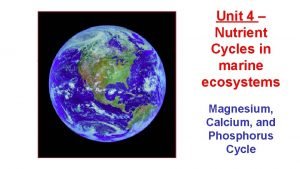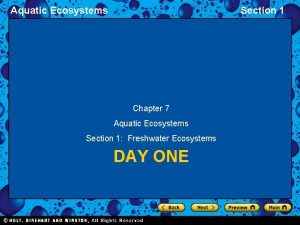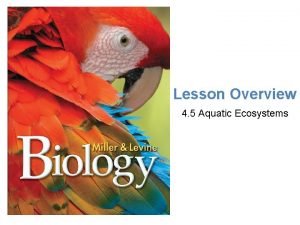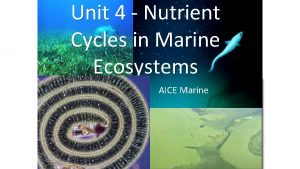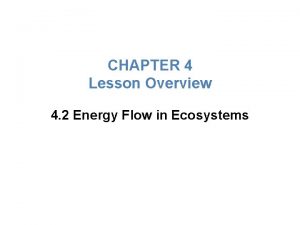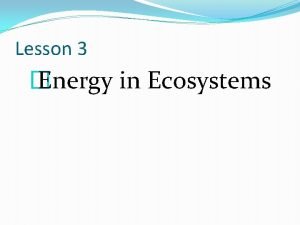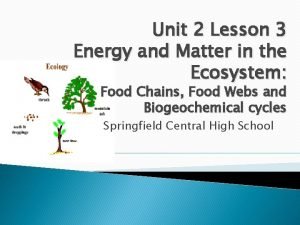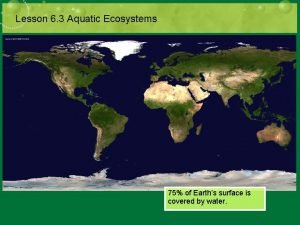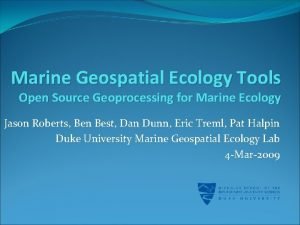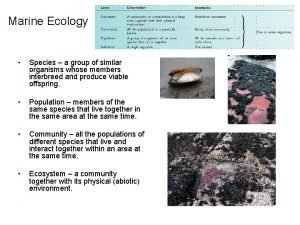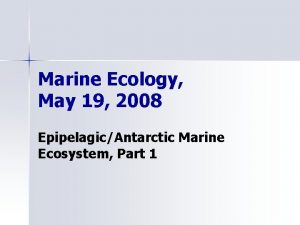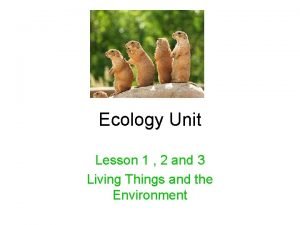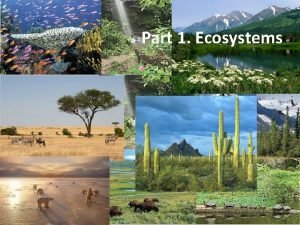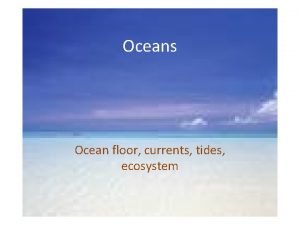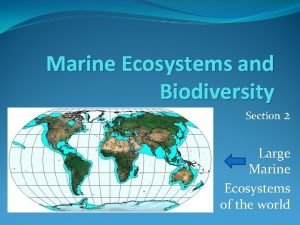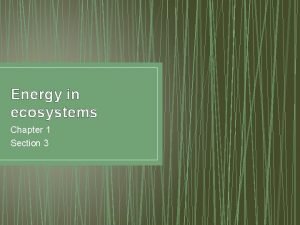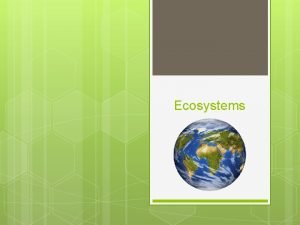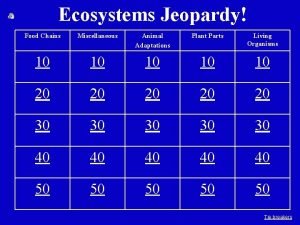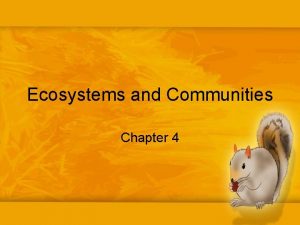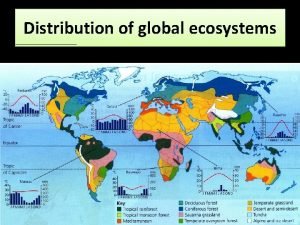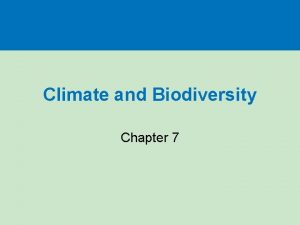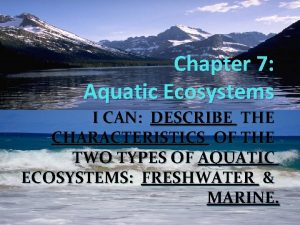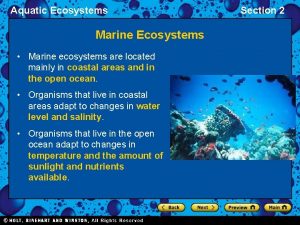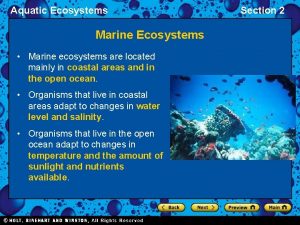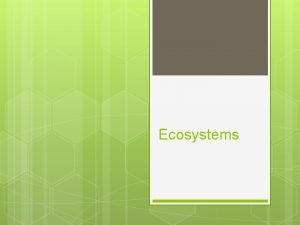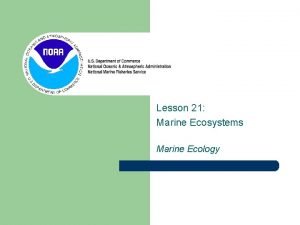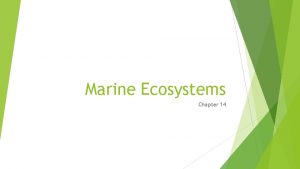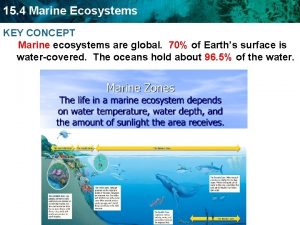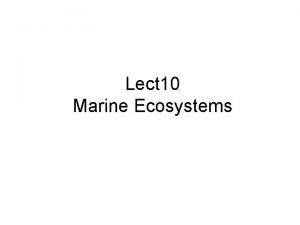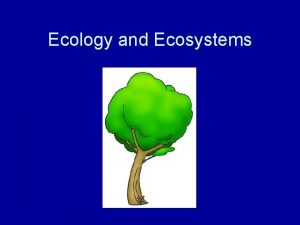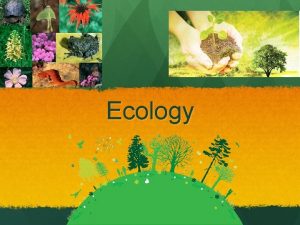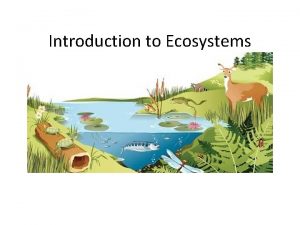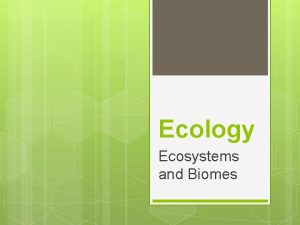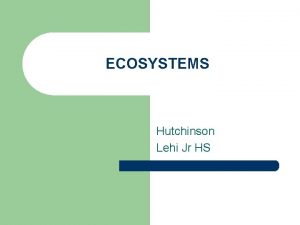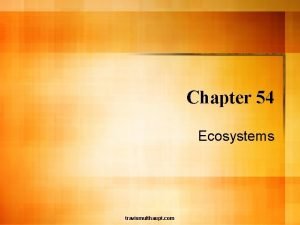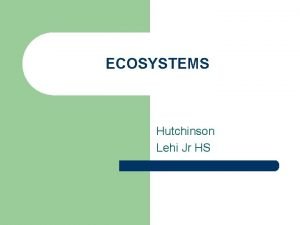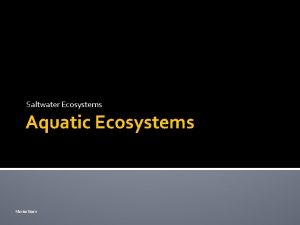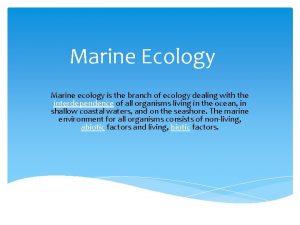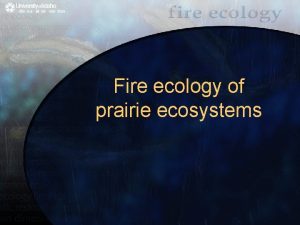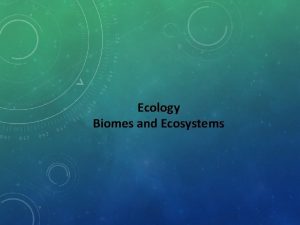Lesson 21 Marine Ecosystems Marine Ecology Marine Ecology

































- Slides: 33

Lesson 21: Marine Ecosystems Marine Ecology

Marine Ecology • Biology – finally! • Why do we care? –Fishing –Water quality –Diversity of species –Medicines

Life in the marine environment 3 l In marine science, it is important to understand why these creatures live where they do and how they interact with their environment l Today we will learn about marine ecology: the study of the relationship of marine organisms with each other and with the environment

Life in the marine environment 4 l The ocean can be divided into zones based on depth (vertically) and distance from land (horizontally) l Different zones of the ocean have conditions that support different organisms l What is an ecosystem? l An ecosystem is a physically distinct area that contains a community of interacting organisms

Ocean zones and continental margins l l l Many ocean zones are defined based on continental margins. To help you understand ocean zones, let’s first review continental Margins: Continental Margin: Submerged area of continents. Include: – – – 5 Continental Shelf (flat gradually sloping seafloor) from shoreline to ~ 200 m; End of Shelf is called the Shelf Break Continental Slope (steeply sloping seafloor) seaward of shelf break Continental Rise (Moderately sloping seafloor) seaward of slope

Pelagic and Benthic zones Photos: NOAA l One simple ocean zone classification is between the water and the ocean floor l The water is referred to as the pelagic zone – l 6 Shark: Pelagic (nekton) Organisms that swim through the water column are known as nekton The ocean floor is referred to as the benthic zone – Organisms that live here are benthic organisms or benthos Crab: Benthic (benthos)

Pelagic and benthic zone divisions Pelagic zone divisions (depth from surface) Benthic zone divisions (seafloor zones) Supralittoral –shore above high tide Epipelagic (0 -200 m) Littoral – the intertidal zone (sometimes submerged and sometimes above water) Mesopelagic (200 -1, 000 m) Sublittoral – seafloor of the continental shelf (from low tide to the shelf break) Bathypelagic (1, 000 -4, 000 m) Bathyl – seafloor of the continental slope to the deep ocean bottom Abyssopelagic (4, 000 -6, 000 m Abyssal – deep ocean bottom between the base of the slope and 6, 000 m Hadalpelagic (6, 000 -10, 000 m) Hadal – the deepest zone, below 6, 000 m 7

Pelagic and benthic zone divisions ide t igh h Littoral w Lo e tid 200 m ic ip ep Bat op s me hyl ic lag 1, 000 m e e ylp h t ba 4, 000 m ic lag Pelagic zone sal ic 6, 000 m g ela alp s ys e zon ys Ab thic n Be 8 g ela ab Had al ha ic lag e lp da

Percentage of Marine Habitats Zone Depth (m) Volume (%) Pelagic Epipelagic 0 -200 3 Mesopelagic 200 -1000 28 Bathypelagic 1000 -2000 15 Abyssalpelagic 2000 -6000 54 Hadalpelagic >6000 <1 Benthic Sublittoral 0 -200 8 Bathyal 200 -2000 16 Abyssal 2000 -6000 75 Hadal >6000 1

Light Zones • Yet another way to classify the ocean • Photic zone – light is sufficient for photosynthesis – to 100 (or 200 m) • Dysphotic zone – light is too weak for photosynthesis – twilight zone – < 5% sunlight – 100 to 200 m • Aphotic zone – no light

Species evolve traits that help them survive in their environment 11 l Species in different environments may evolve different lifestyles, behaviors and physical traits l Species usually are not completely isolated from one another, but interact with other species that live in a shared environment

Lifestyles l 3 Basic Lifestyles: –Plankton –Nekton –Benthos

Plankton l Floaters or very poor swimmers l Plankton divided into 2 groups: – Phytoplankton – producers, photosynthesizers – Zooplankton – consumers

Plankton l Meroplankton – – Spend only part of their life cycles as plankton Are the larval stages of organisms that grow to become benthic or nektonic organisms l Holoplankton – Spend their entire life cycles as plankton

Phytoplankton l l l Must live in the photic zone Most abundant in shallow coastal areas or in upwelling zones The basis of the oceanic food web

Phytoplankton l Cyanobacteria l Diatoms l Coccolithophores l Dinoflagellates

Zooplankton l Foraminifers l Radiolarians l Cnidarians l Combjellies l Arthropods l Larvae

Zooplankton

Nekton (swimmers) l Free swimmers l Maneuver actively in the water column l Found in the water column from surface to ocean floor

Nekton (swimmers) l 5 Categories: Reptiles – Mammals – Fish – Arthropods – Mollusks –

Nekton (swimmers) l Marine Reptiles: – Turtles – Snakes – Crocodiles – Iguanas

Nekton (swimmers) l Marine Mammals: Whales – Seals – Otters – Manatees – Dolphins –

Nekton (swimmers) l Bony Fish: – Tuna – Barracuda – Eels – Angler Fish

Nekton (swimmers) l Cartilaginous Fish – Sharks – Rays – Skates – Chimeras

Nekton (swimmers) l Marine Arthropods – Shrimp l Mollusks – Squid – Octopi

Benthos (bottom dwellers) l Live either burrowed in, resting on, or attached to the bottom l Primarily filter feeders, scavengers or deposit feeders

Benthos (bottom dwellers) l 2 Basic Types: – Sessile - Live attached to the bottom – Vagrant - Able to move about

Benthos (bottom dwellers) l Sessile: – – – Barnacles Sponges Corals Sea Anemones Oysters Clams

Benthos (bottom dwellers) l Vagrant: – – – Crabs Sea Stars Sea Cucumbers Sea Urchins Brittle Stars

What is an ecosystem? Coral Reef l Populations Beach of different species interacting with one another in a shared environment form a community 30 l An ecosystem is a distinct physical entity with unique abiotic (nonliving) conditions that is home to a Intertidal (Splash zone) community of interacting species l Can you think of some marine ecosystems you have learned about in earlier lessons, classes or elsewhere?

Energy is transferred through ecosystems Solar energy is converted to chemical energy by autotrophs Secondary consumers eat primary consumers to get energy Primary consumers eat primary producers to get energy 31 Photos: NOAA

Life in ecosystems is interconnected l l 32 As you’ve probably already realized, the marine environment consists of many distinct ecosystems that contain unique organisms How do you think life within ecosystems is interconnected? Marine organisms form relationships with one another and share space and resources As a result, an impact on a single species in an ecosystem can affect many other species in the same ecosystem

Important interactions Photo: NOAA l It is important to manage our natural resources in a way that reflects the interconnectedness of ecosystems and their components l Ecosystem-based management (EBM) is a management approach that includes these interactions instead of Management of ecosystems, like this bleached considering single species or coral reef, requires looking beyond just the single issues at a time coral itself. Other important factors to study l 33 might include pollution, development, watershed management and interactions with NOAA applies EBM in its management of marine resources other species.
 Lesson outline lesson 2 aquatic ecosystems answer key
Lesson outline lesson 2 aquatic ecosystems answer key Phosphorus cycle pearson education
Phosphorus cycle pearson education Chapter 55 ecosystems and restoration ecology
Chapter 55 ecosystems and restoration ecology Magnesium cycle in marine ecosystem
Magnesium cycle in marine ecosystem What two locations are marine ecosystems usually located?
What two locations are marine ecosystems usually located? Photic and aphotic zones
Photic and aphotic zones A terrestrial food web
A terrestrial food web Chapter 4 lesson 2 energy flow in ecosystems answer key
Chapter 4 lesson 2 energy flow in ecosystems answer key Which marine ecosystem contains the fewest producers
Which marine ecosystem contains the fewest producers Chapter 3 lesson 3 biomes and aquatic ecosystems
Chapter 3 lesson 3 biomes and aquatic ecosystems Phosphorus cycle
Phosphorus cycle Lesson 4: energy flow in ecosystems
Lesson 4: energy flow in ecosystems Lesson 3: aquatic ecosystems
Lesson 3: aquatic ecosystems Marine geospatial ecology tools
Marine geospatial ecology tools Group of similar organisms
Group of similar organisms Marine ecology
Marine ecology Marine ecology
Marine ecology Marine geospatial ecology tools
Marine geospatial ecology tools Lesson 1: introduction to ecology answer key
Lesson 1: introduction to ecology answer key Introduction about water pollution
Introduction about water pollution Section 3 aquatic ecosystems worksheet answers
Section 3 aquatic ecosystems worksheet answers Ecosystem living and nonliving things
Ecosystem living and nonliving things Ecological succession
Ecological succession Shark food chain
Shark food chain Ecosystems examples
Ecosystems examples Interactions in the environment grade 7
Interactions in the environment grade 7 Section 3 energy in ecosystems
Section 3 energy in ecosystems Ecosystem title page
Ecosystem title page Abiotic factors examples
Abiotic factors examples Adaptations of a dandelion
Adaptations of a dandelion Ecosystems and communities chapter 4 answer key
Ecosystems and communities chapter 4 answer key Distribution of global ecosystems
Distribution of global ecosystems Human impact on terrestrial ecosystems
Human impact on terrestrial ecosystems Aquatic ecosystems webquest
Aquatic ecosystems webquest



